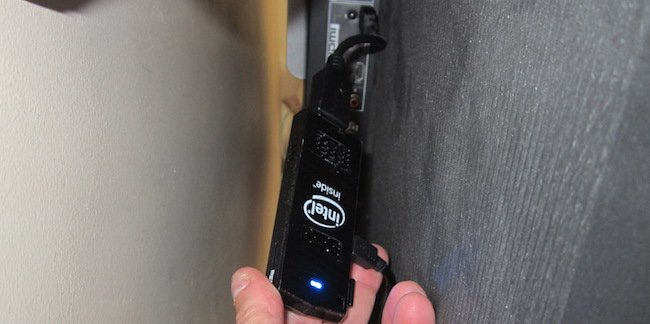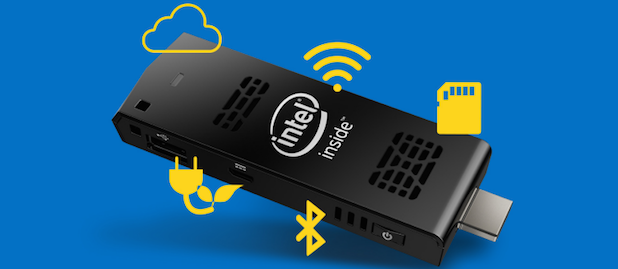Review: Intel Compute Stick
For cord-cutters (or those leaving cable tv behind), I usually recommend one solution. You need to have a full desktop or laptop computer running Windows, OS X, or Linux attached to your television via an HDMI port. Other options just don’t provide the kind of flexibility that’s required in such a changing landscape. It seems like Intel was listening to me and created a small computer for this purpose. Can this device replace the “Computer attached to Television” scenario I recommend?
Connecting the Compute Stick to the television was easy, I simply had to plug it into a free HDMI port and turn the device on. I started with a USB keyboard to get the device setup and connected to WiFi first. Then, you’re in Windows 8.1, ready to go. Getting the right resolution for my TV set was much more difficult. My television didn’t offer a lot of resolution options, and the Intel Graphics tools lacked the ability to fine-tune the video size. Given that, there was no way to create an optimal display showing the entire desktop without black bars around the screen [1].
The specifications are light for some features. The unit I tested only supported 802.11bgn WiFi [2] and the single USB port is 2.0 [3]. Given that this device requires these two specifications for core operations, I wonder why they didn’t push as much as possible into the build. Perhaps more unusual is that the processor is 64-Bit capable, but Intel chose to use the Windows 32 bit edition [4]. Another version should be available now that includes Ubuntu 64 bit.
The Quad-Core Intel Atom Z3735F Processor was prominently displayed on the box (as well as marketing materials), but would it be fast enough? While I didn’t perform any sort of software-based speed test, my perception was that this computer wouldn’t handle more than one task so well. I’d like to see how it runs with Ubuntu 64bit installed. For the applications I did install, there were no major issues.
How would the included graphics card and CPU handle video playback? I was pleasantly surprised that it would handle 720p video with no issues. Testing on Youtube, video at 1020p performed well, but 4K videos were choppy. While the speed still felt slight compared to what I’d expect in a full-size computer, the power was clearly more than enough to handle what I was doing. Online streaming services posed no problems including tested with YouTube and Netflix.

The biggest complaints I have with this device are the Wireless reception coupled with the included extension cord. Since the device is so small, wireless becomes more of a challenge to pick up at longer distances. So, where a computer might have had no issues, the Compute Stick needs to better see the signal. But, because it’s stuck behind the TV (in an HDMI port), the TV itself interferes with reception. At the very least, you’d want to get it out from behind the TV right? Well, the extension cable is not more than a few inches and won’t do much to help. In my case, I needed to bring an access point closer to get a reliable connection. Your current setup may not be strong enough to stream video.
The device also stays relatively cool sitting behind the TV. Intel has done great work considering the power and size of this device. i was expecting the Compute Stick to be incredibly hot in non-stop operation.
If you’re looking to turn a TV set into a usable computer, this could work well. For a boardroom television running networked presentations (like Prezi), this device seems ideal. As a replacement computer for cord-cutters, the Compute Stick is just about as good as it gets. Coupled with a local NAS, and you have everything you need to walk away from cable. I do hope Intel sells enough of these to build future generations.



